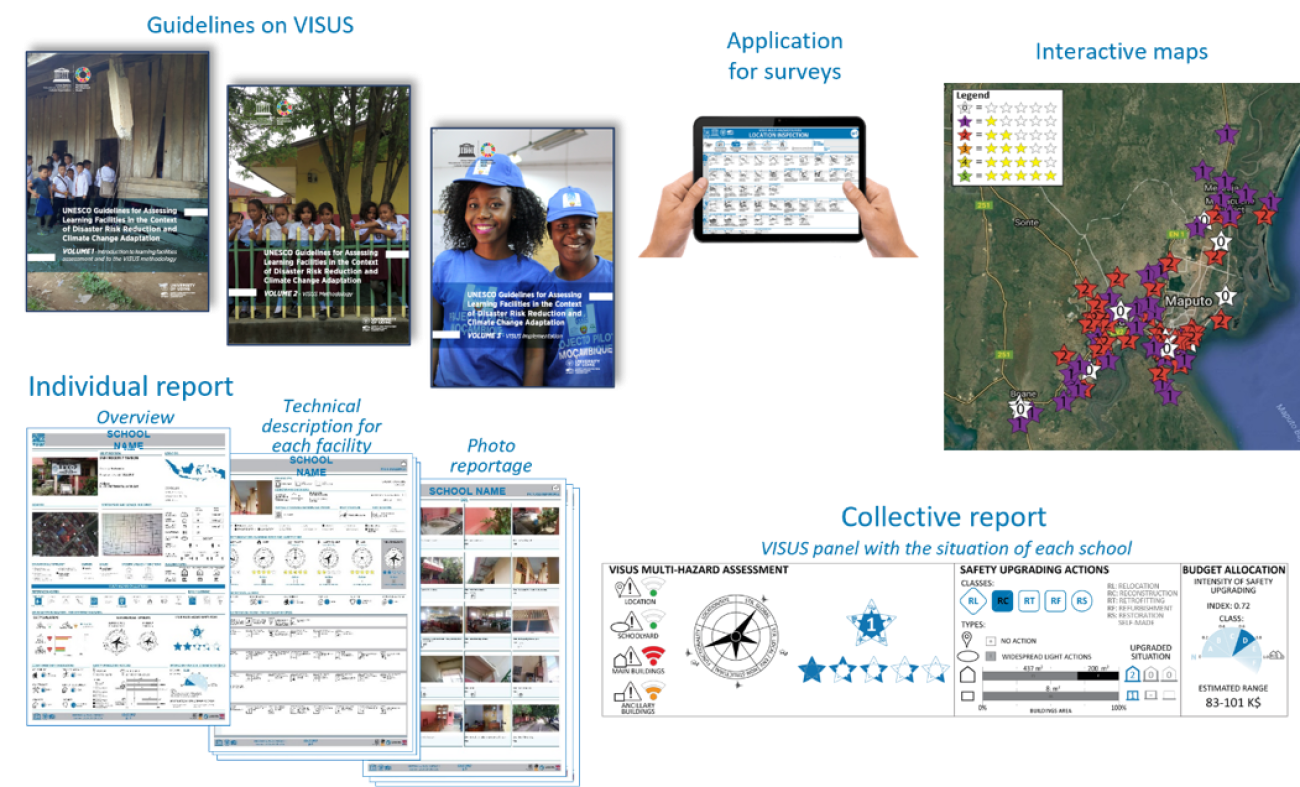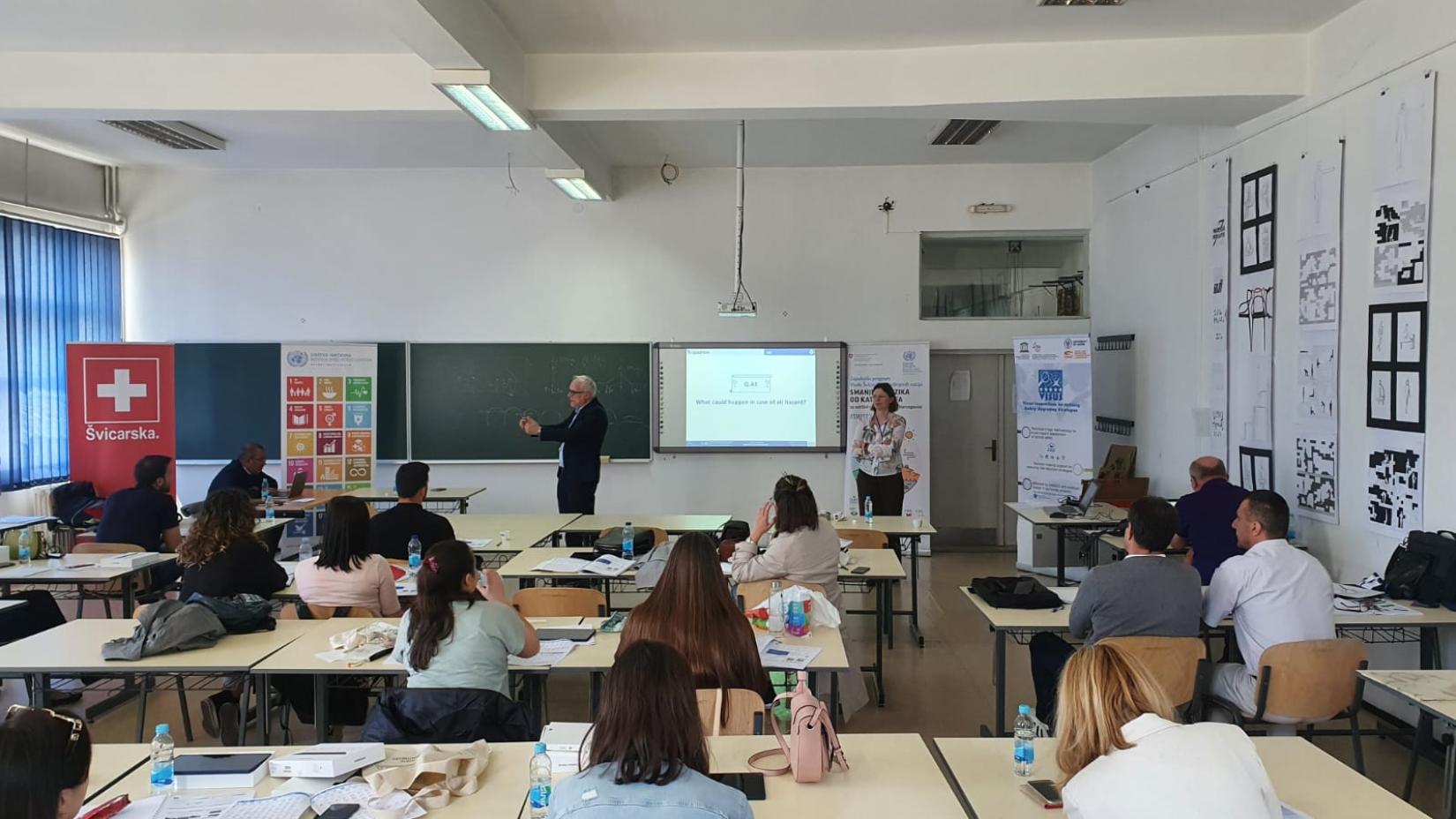VISUS Methodology for Comprehensive School Safety and Disaster Risk Reduction in Bosnia And Herzegovina

The UNESCO facilitated methodology is introduced as part of the Joint Swiss - UN Programme on “Disaster Risk Reduction for Sustainable Development in BiH"
As part of the Joint Swiss UN Programme “Disaster Risk Reduction for Sustainable Development in Bosnia and Herzegovina” and the “Comprehensive School Safety” model, UNESCO, through its Antenna in Sarajevo of the Regional Bureau for Science and Culture in Europe, is promoting and facilitating the application of the ‘Visual Inspection for defining Safety Upgrading Strategies’ (VISUS). The project outlines a methodology for the multi-hazard safety assessment of schools, fundamentally aiming to improve institutional capacities, frameworks, public services and partnerships at the local government level in Bosnia and Herzegovina. Following the targets of the SDGs, VISUS intends to make populations in risk-exposed localities less socially and economically vulnerable to the effects of disasters and climate change.
The socio-economic development of Bosnia and Herzegovina is detrimentally impacted by the population’s high vulnerability to natural hazards, which itself is further inhibited by the country’s institutional and governmental lack of technical, organisational and financial capacity. This vulnerability extends to various sections of the local community, and notably to schools. VISUS aims to address this growing concern, by strengthening local coordination mechanisms for Disaster Risk Reduction (DRR), and reaffirming the strategic risk prevention planning process through cost and time effective assessments of learning facilities.

The implementation of this project is expected to prevent the negative effects of disasters and climate change on educational facilities. Furthermore, in line with SDGs 4 and 11, quality education and sustainable cities and communities, the project will enhance holistic disaster risk governance and quality of life improvements in at-risk municipalities, materialising as reductions in socio-economic vulnerabilities of citizens and institutions.
VISUS is a priority-based methodology for conducting Visual Inspections for the definition of Safety Upgrading Strategies, defined by SPRINT-Lab researchers and adopted by UNESCO for the safety assessments of learning facilities worldwide. In practice, this involves identifying and selecting the most critical sites to be assessed first. The methodology provides decision makers with the tools and information they need to make science-backed decisions, relating to where and how to implement available resources for improving school safety. The methodology underlines the process to carry out these procedures whilst ensuring cost and time effectiveness.
Following successful pilot tests in 7 countries (Italy, El Salvador, Laos PDR, Indonesia, Peru, and Haiti and Mozambique), the methodology is being implemented for safety assessments in Bosnia and Herzegovina, in close cooperation with Universities in Sarajevo and Banja Luka. The application of VISUS will enable the identification of necessary upgrades, considering multi-hazard perspectives, to the safety measures of 40 schools in 10 project communities across the country. These assessments will widely enhance the educational institutions, but more specifically, benefit students, teachers and other school staff members, by establishing a safer working and studying environment.
„With the implementation of VISUS, UNESCO assesses the safety conditions of schools considering Earth-, Water-, Air-, Fire-, Ordinary use-related hazards. The methodology facilitates a technical triage based on visual inspection, the results of which can be directly used for defining comprehensive safety upgrading strategies for school facilities.“
Petra Malisan, Researcher at UNESCO-Chair on Intersectoral Safety for Disaster Risk Reduction and Resilience
The VISUS methodology has been developed through the collaboration of VISUS researchers and local experts, such as university professors, technical staff and UNESCO representatives. The involved professors, acting as BiH VISUS Survey Coordinators, are trained by SPRINT-Lab researchers to conduct surveys in schools and gather data for the methodology’s results. The main targets of VISUS are to assist decision makers (e.g. educational authorities) to determine which schools require priority intervention, what type of intervention is required, the cost of required intervention, and which upgrades are most feasible based on available resources. Notably, in line with SDG 4, the main beneficiaries of VISUS will include students and teachers, as the project aims to improve school facility safety and accessibility. Fundamentally, the VISUS methodology will suggest enhancements that will promote a conducive environment for learning and growth.
„We, at UNESCO, prioritize strengthening and supporting the educational institutions which drive our contribution to the project in engaging and empowering educational partners. For this reason, UNESCO is closely collaborating with local stakeholders, experts and relevant authorities to undertake the assessments for the necessary and sufficient DRR preparedness“
Sinisa Sesum, Head of Antenna in Sarajevo, UNESCO Regional Bureau
The “Disaster Risk Reduction for Sustainable Development in Bosnia and Herzegovina” is a joint initiative supported and financed by the Government of Switzerland and the United Nations. The collaborative project is being jointly implemented by the UN agencies: UNDP, UNICEF, UNESCO, UNFPA and FAO, in collaboration with authorities in Bosnia and Herzegovina.





